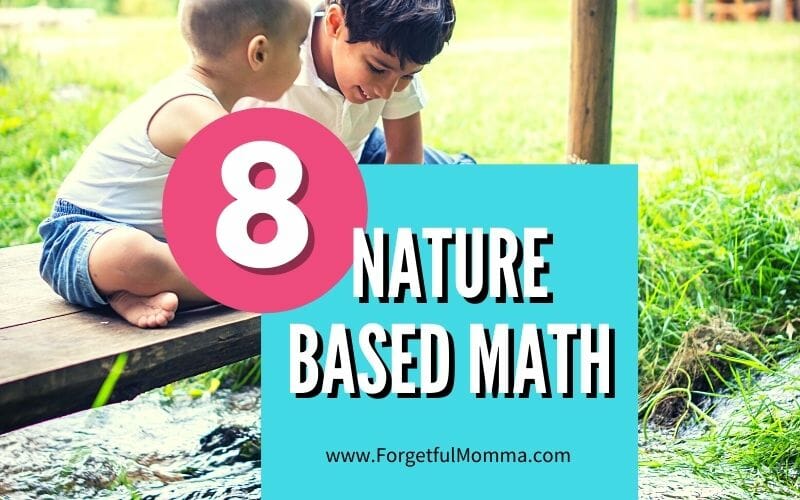Math is a great subject to do outdoors! We know that time in nature improves problem-solving skills and promotes creativity! These are both skills we want in our math learners. Nature-based math lessons can take place without a plan, just head out for a nature walk.

This post contains affiliate links, see my disclosure policy for more information.
What is Nature Based Math?
Nature based math is math using natural materials for lessons, mathematical concepts observed in nature, or applying math to solve problems in nature. It usually looks like using acorns for counters or doing math facts in the sand on the beach.
These math activities are a great way to incorporate nature into your math learning at home. I will give you a list of some other great ideas at the bottom of this article.
Nature based learning has a lot of benefits for children and these can become very important as you begin to explore mathematical concepts with your children.
Focus
Nature increases focus. If math is a constant struggle, try doing the lessons outside. Just bring the workbook outside, get a chair or hammock and make it a habit.
Problem Solving
Spending time outside gives children the chance to take risks and get immediate feedback.
Can I climb this tree? Maybe. Can I lift this rock? Maybe. Will this work? Yes
This increases creativity which is necessary for math. Children need to be able to approach a math problem knowing that there are several ways to solve it. And without a calculator.
Positive Feelings
Creating positive feelings around math is very important. Time in nature can help your child build those positive feelings around math. When they think about math they will feel good not terror and that will make them better students of math.
Ideas for Nature Based Math
You can incorporate nature-based learning into your math learning every day and see the benefits for your student.
Natural Counters
The best way to start incorporating nature in your math is to start counting things outside. Rocks work well, acorns, sticks, or leaves are all great choices. You can use them to learn to count or group them for multiplication and division.
You can challenge your child to collect 20 items and put them in a bowl for counters in your indoor classroom. Or simply to practice counting to different numbers.
Math in the Dirt
Do the math with a stick or finger in the dirt or in the sand at the beach. This makes the problems more tactile, it is the same concept as those sandpaper letters that are so helpful in early education.
Pairing the math facts with the feeling of hands in the dirt helps them wiggle their way deep into the brain.
Patterns in Nature
There are observable patterns in nature and those are worth observing.
- the rings on a cut-down tree
- the symmetry of leaves and flower petals
You can also use natural materials to create patterns. These patterns can be an engaging activity for young and old students.

Curriculum
Wild Math is an incredible resource for families who would like to do a nature-focused math curriculum. It is a full curriculum for grades K-5 and it is rooted in nature.
Outdoor Classroom
Create an outdoor classroom at home to make getting outside easier. A picnic table in the backyard is a great outdoor classroom, but you can also assemble a circle of cut logs or hay bales. A shed that you can use to keep learning outside, even in the rain.
Shapes
Natural objects can offer great insight into geography, why are circles more common than rectangles in nature? Volume, surface area, and mass are all explored in this question.
How many different shapes can you see in nature?
Do a Project
Choosing a project that involves math and nature is a great way for your child to make connections.
You may choose to build that picnic table in your yard, requiring a study of the natural landscape and math, or study climate change and learn the troubling data that is driving change.
The best projects stem from the observation of a problem. So if your child is troubled by the amount of trash on the beach, work together to see what solutions you may be able to apply to math.
More Nature-Based Learning
Nature Based Learning in Your Homeschool
